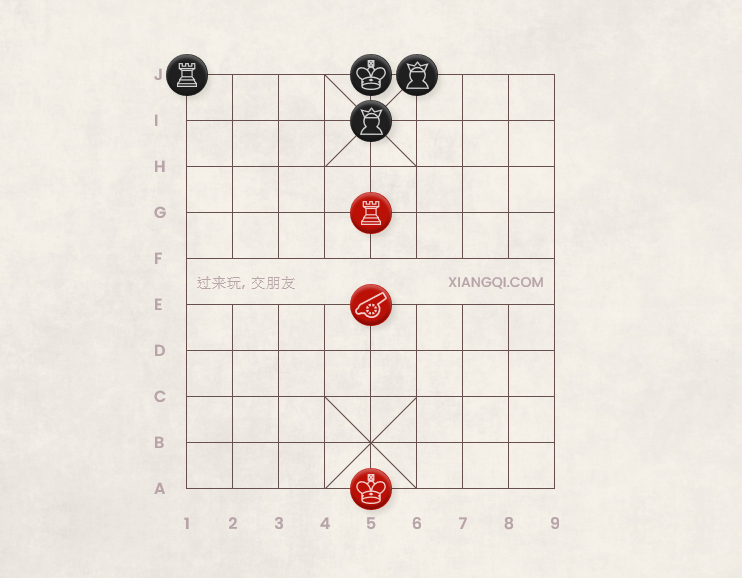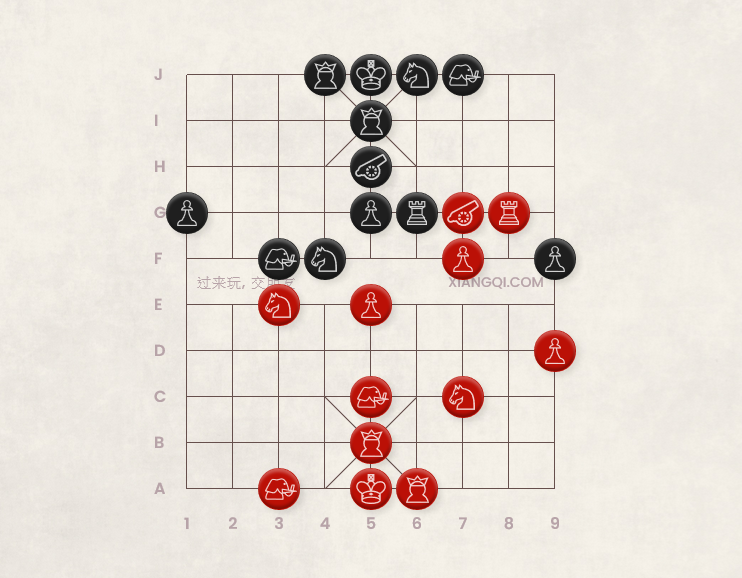Basic Xiangqi (Chinese Chess) Midgame Tactics 06 Discovered Attacks/Checks
Author: Jim Png from XqInEnglish
This article is the sixth article in a series of articles introducing the basic tactics used in Xiangqi (Chinese Chess). In this article, the author will introduce Discovered Attacks and Discovered Checks.
The article will be divided into the following sections:
What is a Discovered Attack/Check?
Why Discovered Attacks/Checks are more common in Xiangqi
Example 1: Resolving Checkmate threats and Turning the Tables
Example 2: Example of Setting up a Discovered Attack
Example 3: A variation of a Discovered Attack
What is a Discovered Attack/Check?
By definition, a discovered attack occurs when moving a piece will reveal another piece that is attacking. As the moving piece can also be used to attack, it often results in two simultaneous threats. The opponent would usually be unable to deal with both threats simultaneously, thus allowing the attacking party to make gains in the situation. It is a very potent form of a DOUBLE ATTACK.
If moving a piece results in a check, it would be called a Discovered Check. A Discovered Check is the most potent form of a Discovered Attack as the opponent MUST resolve the check.
A Discovered Attack is called 闪击 (shǎn jī), while a Discovered Check is called 闪将 (shǎn jiāng). If material is captured, it is called 抽将 (chōu jiāng) or Capturing Material with a Discovered Check.
While capturing material may be the most commonly used purpose of applying a discovered attack/check, this tactic can also be used for various other purposes. For example, they can be used to disrupt the enemy's formation, increase one's initiative, block and halt enemy attacks, achieve a winning position, et cetera. Therefore, there are many more uses of discovered attacks other than capturing enemy material.
The concept of a Discovered Attack or Discovered Check is not alien to International Chess players.
Discovered Check is the Dive Bomber of the Chessboard – Reuben Fine
An introduction to Discovered Attacks/Checks is best started with the following example.
Diagram 1 Discovered Check explained
In the situation shown in Diagram 1, it would be Red's turn to move.
Red will play R5=9 which is because after moving the Chariot away, the Red Cannon will be delivering a check. Black must resolve the check by moving his King away or moving the Advisor so that the Red Cannon cannot constitute a check.
Unfortunately for Black, he would lose the Chariot either way.
Why Discovered Attacks/Checks are more common in Xiangqi
Discovered Attacks and Discovered Checks tend to occur much more frequently in Xiangqi than in International Chess. This author believes that the phenomenon is probably due to the following reasons:
l Pieces (Horse and Elephant) can be blocked in Xiangqi. For example, if a Chariot were blocking a friendly Horse whose scope included enemy pieces, moving the Chariot to attack another area would result in both the Chariot and Horse attacking.
l The presence of the Cannon. When the Cannon attacks, it needs a cannon mount. If the cannon mount is a friendly piece, it can be also be used to attack such that a discovered attack is formed.
l The bigger chessboard in Xiangqi and fewer impediments like Pawn Structures. As mentioned in an earlier article about the difference between International Chess and Xiangqi, the coefficient of firepower density was different. Xiangqi boards are much bigger (90 intersections vs. 64 squares), and there are no Pawn Structures in Xiangqi which may cause congestion such that it would be harder to set up discovered attacks/checks.
Indeed, the Cannon-Chariot combination is perhaps the most commonly seen tactical unit delivering discovered attacks or discovered checks. Another widely used combination is the Chariot-Horse combination.
Indeed, several basic kills make use of the tactic of a Discovered Attack and Discovered Check to achieve winning positions. The Detonating Mine Attack, White Horse Checkmate, Drawer Checkmate, et cetera are basic kills whose central theme is the Discovered Attack/Discovered Check.
Example 1: Resolving Checkmate threats and Turning the Tables
Diagram 2 Example 01
This example was from arbiter Zhu Baowei's book. (1 页 146)
A quick analysis of the game would show Red's 2r1c combination vs. Black's 1r1h1c1p combination. It is Red's turn to move.
Black is about to checkmate with R3+2. How can Red use the discovered attack tactic to turn the tables?
1. R2=7! …………
Discovered attack! This move
1. ………… R3=8
Black is forced to make this move to prevent Red's potential checkmate. Black would also threaten to checkmate with R8+2.
If he moved E7+9, the Black Chariot is lost, as would be the game: 1. ………… E7+9 2. C2+6 …………
Red threatens to checkmate with R4+1.
2. ………… A5+6 3. R7-4
Red wins for sure!
If Black captured the Red Chariot, Red would checkmate with the following moves: 1. ………… R3-4 2. C2+6 A5-6 3. R4+1 K5+1 4. R4-1. Checkmate.
2. R7=3! …………
Red threatens to checkmate with R3+3 followed by R3=4. Red would also resolve Black's checkmate threat. If Black checked with R8+2, Red could defend with E9-7.
2. ………… E7+9
Black tries to resolve Black's checkmate with this move. Red cannot play R3+3 for the checkmate now.
3. C2+5! …………
Red blocks the Elephant with this move and still threatens with R3+3.
The moves in the book ended here for this example.
The following moves belong to a possible line that was generated by the computer. Red would capture material and overwhelm Black with material superiority.
3. ………… R8+2 4. E1-3 R8=7 5. R3-6 E5+7
6. C2+1 A5+6 7. R4-1 C2-7 8. R3+3 C2=4
9. R4+1 C4+2
Black cannot play A4+5 or Red checkmates with R4+1.
10. R3-1 C4=9 11. R3=2 C9=6 12. R2=5 C6=5
13. R5+4 H4-5 14. R5=4 H5+6 15. -R=3 A4+5
16. R3+3 A5-6 17. R3=4
Checkmate.
In this example, Red initially used a discovered attack to resolve Black's potential checkmate and set up a kill of his own.
Example 2: Example of Setting up a Discovered Attack
Diagram 3 Example 02
This example was given in Grandmaster Liu Dianzhong's book. (2)
It shows a brilliant discovered attack with the Chariot-Horse Combination.
The following explanations were by the author.
1. H4+6 K5=4
If Black used the Chariot to capture the Red Horse, Red checkmates with R4+6.
2. H6+8 K4+1
Again, if the Black King plays K4=5, Red checkmates with R4+6.
3. C5=9 …………
Red eliminates an immediate threat and also threatens to checkmate with C9+6.
3. ………… P2=1 4. R4=7 …………
The Red Chariot is now finally in place.
4. ………… R4=2
In the book, R4=2 was given. Black could also attempt to check with R4=6, but it would not have any significant consequences. Black would have to move the Black Chariot to this file eventually.
5. R7+5 …………
At this point, the Red Chariot is delivering a check.
5. ………… K4-1
If Black tried to move his King to the Cannon Rank with K4+1, Red would immediately play R7-2! It would be a discovered check. If Black captured the Red Horse, Black would checkmate with R7=6.
Black can only retreat his King K4-1 and lose his Chariot. Red will win for sure!
6. R7+1 …………
Discovered check. Both pieces are delivering checks.
This intermediate move is essential as one of Black's defensive pieces is taken out. It would make it much easier for Red to win later on than playing R7=5 at this point.
6. ………… K4+1 7. R7-1 K4-1 8. R7=5 …………
Red captures the Central Advisor in the second discovered check, thus preventing the King from playing K4=5.
8. ………… R2-2 9. R5=8
Red would be sure to win.
Red captures the Black Chariot. The remaining Black Pawns and Horse are scattered and cannot serve as a functional unit. The Red Chariot will hunt down the pieces one by one for the easy win.
Example 3: A variation of a Discovered Attack
Diagram 4 Another variation of the Double Attack
This example was also from Grandmaster Liu Dianzhong's book for beginners. (2)
It is Black's turn to move. The example will demonstrate another type of discovered attack. The position shown was taken from an actual match, but the Grandmaster did not furnish any other information.
1. ………… P1+1 2. P9+1 …………
Black offers the Pawn as a sacrifice, thrusting Red into a dilemma! If Red did not accept the offer, the Black Pawn would have crossed the river to obtain a winning position.
2. ………… C1-2!
The reason for sacrificing the Pawn becomes clear. This is a double attack. The Black Chariot is threatening the Red Cannon, and the Black Cannon is threatening the Red Chariot.
3. C8-2 …………
In the book, C8-2 was given. However, Black could have offered more resistance by playing R1+1. This line was not provided in the book. A possible line is:
3. R1+1 R2+1 4. R1=5 R2+3
It would appear that Red might have a chance of forcing a draw after all. However, Red's left flank was void and vulnerable to attacks by the Black Chariot and Cannon.
5. A5-6 C1+3 6. R5=7 …………
Even if Red plays R5-2 to prevent his Chariot from being captured, Black will continue with R2-4 for the discovered check and capture the Red Pawn for the winning position.
6. ………… R2-4 7. R7-4 R2=1
The situation on the board has now liquefied into Red's 1r2a vs. Black's 1r1c2a2e. It would be a book win situation for Black.
3. ………… C1=5!
Black delivers a check which Red must resolve immediately.
If Red captures the Black Cannon with the Chariot, the Red Chariot is lost. The presence of the Black Pawn will mean that Red CANNOT force a draw with his 1c2a combination. (Note: A combination of 1 Cannon and 2 Advisors can force a draw against an enemy Chariot.)
If Red moved his King or Advisor, the Red Cannon would be captured. This would be a book win situation for Black.
In this example, Black's double attack is slightly different from the earlier examples. But the definition of a Discovered Attack can still be applied. By moving the Black Cannon C1-2, Black simultaneously attacks both the Red Cannon and Chariot. Such tactical combinations are pretty commonly seen in actual play.
Example 4: Discovered Attacks/Checks leading to a kill
The following example was found in Basic Xiangqi Tactics by Cheng Mingsong. (3)
Diagram 5 Example 4
This example was taken from Basic Xiangqi Tactics by Cheng Mingsong. The Chinese Xiangqi Association approved the book.
A simple analysis of the situation would show that Red had the upper hand. It was Red's 1r2h1c vs. Black's 1r2h1c combination, but Black was under heavy attack, and his pieces were congested. Both colors had a full guard, but Black's defense was scattered and weak. Although both colors had three Pawns apiece, one of Red's Pawn had already crossed the river and was already a significant threat.
How can Red further his advantage?
1. P5+1 …………
! Key move. Red would bust open Black's last shred of defense with this move. Black is now placed in a hopeless predicament.
1. ………… H4-3
If P5+1 were played, Red would play C3=9! to threaten to checkmate with C9+3 (Smothered Cannon Checkmate). Black would be forced to lose his Chariot to resolve this threat by capturing the Red Cannon.
If C5+2, Red would deliver a discovered check with C3=5!
Either way, Black would lose the Chariot and the game.
2. P3=4 R6-1 3. P5+1 C5=4
Black would lose material if H3+5 were played.
3. ………… H3+5 4. C3=9 H5-3
5. C9+3 H3-2 6. R2=8
Red will capture the Black Horse and threaten to checkmate. Red will have gained a winning situation.
Black will still lose if he tried to sacrifice material to push for a draw. This variation was not given in the book. For example, if Black played R6+2:
3. ………… R6+2 4. P5+1 R6-1
5. P5+1 A4+5 6. H3+2 H3+4 7. R2+1 H6+5
8. C3=1
The Red Cannon is now freed to attack. Red has the material and positional advantage that translated into a winning position.
4. P4+1 R6=7 5. H3+5
Red would now have gained a winning position. The linked Pawns would continue to cause havoc. It would be just a matter of time before Red won.
Summary
Discovered attacks and checks are a very potent form of Xiangqi tactics. If they are allowed to materialize, the opponent will suffer significant losses. Discovered checks force the opponent to react immediately. It is a commonly seen tactic in Xiangqi and a joy to watch.
Works Cited
1. 朱, 宝位. 棋牌入门丛书 象棋入门. 合肥 : s.n., 1994. 978-7-5337-0734-7.
2. 刘, 殿中. 象棋新编教程 象棋初学门径. 北京 : 北京体育大学出版社, 2000. 7-81051-484-9.
3. 程明松. 象棋基础知识丛书 象棋基本战术. 无出版地 : 成都时代出版社, 2006. 7-80548-428-7.
4. 刘殿中. 象棋新编教程 象棋中局战法. 北京 : 北京体育大学出版社, 2003. 7-81051-905-0/G.756.
5. contributors, Wikipedia. Xiangqi. Wikipedia, The Free Encyclopedia. [Online] Page Version ID: 1031515692, Jul 2, 2021. [Cited: Jul 8, 2021.] https://en.wikipedia.org/w/index.php?title=Xiangqi&oldid=1031515692.
6. 王, 贵龙. 象棋名词术语手册. 呼和浩特 : 远方出版社, 2000. 7-80595-652-9.
7. 黄少龙. 象棋入门初步. 成都 : 成都时代出版社, 2009. 9787807055228.






